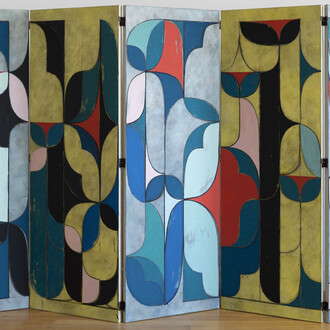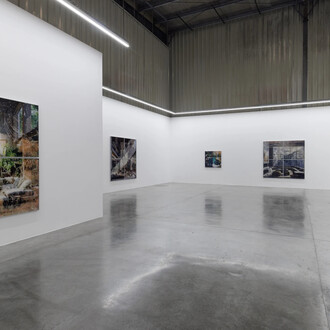Artbooth Gallery Abu Dhabi unveils Steven Naifeh’s Found in translation: a celebration of geometry in the Art of the Islamic World. This exhibition is organized under the patronage of HE Zaki Nusseibeh, Cultural Advisor to the President of the UAE and the Chancellor of UAE University.
Opening on November 8, 2024, this is the first solo exhibition in Abu Dhabi of works by Naifeh in almost exactly 50 years.
Artbooth Gallery is delighted to present Found in translation, a significant exhibition that underscores the crucial importance of geometric art in the Middle East to geometric art throughout the world. The exhibition runs from November 8 to December 8, 2024, at the Artbooth Gallery’s space, located on the ground floor of Centro Capital Centre by Rotana, ADNEC area, Abu Dhabi.
Reviewing Steven Naifeh’s groundbreaking 1975 show in Abu Dhabi for the U.A.E. news, a reporter wrote, “An exhibition in Abu Dhabi is a rare happening. But an exhibition of work mainly created in Abu Dhabi is probably unique. ... I cannot wait to see more of [Naifeh’s] work and have a strong suspicion that in ten years or so anyone who was lucky enough to have seen this exhibition, will be boasting – oh yes, I saw this collection when they were originally shown in Abu Dhabi way back in 1975. ...”.
HE Zaki Nusseibeh says: “I am delighted that the exhibition by Steven Naifeh, Found in translation, is being shown in the UAE. The artist’s parents were close friends of mine when they lived in Abu Dhabi during the 1970s. Steven, whose family is of Arab origin, grew up in the Arab and Islamic world. His art is closely tied to his family’s stay and experience in the UAE as well as to his crucial inspiration from Islamic Art. I have long admired Steven’s art and its high relevance to the burgeoning art scene throughout the region”.
For over a thousand years, artists from Moorish Spain to Northern India have used geometric art to represent universal harmony. Naifeh’s large works find their influence within this glorious Middle Eastern heritage, while deftly integrating the great tradition of geometric abstraction in the United States and Europe from Kazimir Malevich to Sol Lewitt.
As the son of US diplomats, and grandson of two people born in what are now Lebanon and Jordan, Naifeh spent his youth across the Middle East, Africa, and South Asia. He lived not only in the United States and in the UAE but in Jordan, Iraq, Iran, Libya, Oman, Pakistan, and Nigeria, exploring and absorbing the world around him, including its many mesmerizing artistic cultures. Naifeh then returned to the US to pursue art history at both Princeton and Harvard, expanding his purview beyond the ancient abstract works of his childhood to include the formal academies of Europe and America.
Drawing on this unique artistic journey, Naifeh has created a captivating body of work that is both physically imposing and intricately wrought. The pieces featured in the exhibition are representative examples of the power and grace of Naifeh's art, as seen in major public installations and museum collections around the globe.
In both paintings and sculptures, Naifeh takes specific precedents from millennium-old Islamic and Arab prototypes that were inspired by mathematical principles, removes them from their temporal and material context, and reimagines them in the world of twentieth-century international art. He uses scale, dimension, and media in a way that addresses both the ongoing redefinition of painting and sculpture throughout the world and the spirituality of Islamic and Arab art. Following in the footsteps of American geometric abstractionists like Frank Stella, who derived the images for their paintings from the formal properties of their underlying surface – in particular, the shape of the canvas – Naifeh has continued to explore the uncertain status of the traditional easel painting by transposing two-dimensional images into three-dimensional wall sculptures.
The harmonic growth patterns in Naifeh’s Starburst Series, for example, come directly from Arab models. The sometimes-hidden controlling proportions in his Horizon Series have Arab and Islamic antecedents as well. The complex geometries of carved Mughal screens provide the inspiration for his Jali Series.
Naifeh names his works after people and places from his past: names that have personal meaning for him. "Saida" was his paternal grandmother’s name. It is Arabic for “happy”. His great-aunt was named “Wadia”; she was ninety-two when he met her in 1979. She was still living in “Ajlun”, the village in Jordan where his grandfather was born, in the shadows of the ruined fortress of Saladin the Great.
“Because [Naifeh’s] works emphasize the formalist aspects of art”, according to that 1975 review, “they are particularly appropriate for exhibition in Abu Dhabi for Islamic art is also basically a formalist art. ... The hard-edge canvases and Minimal sculptures of Steven Naifeh may seem radical, but they bear close visual and philosophical similarities to art created in the Arab world for over a millennium”.
Steven Naifeh is an artist whose works are included in numerous museum and public collections and have been exhibited extensively throughout the Middle East, the United States, Africa, and Asia.
After studying art history at Princeton University, Naifeh received degrees from both the Harvard Law School and the graduate program at the Fogg Art Museum of Harvard University, where he collaborated with Glenn Lowry, now Director of the Museum of Modern Art, on a study of the influence of traditional Islamic architecture on the wave of new construction that swept across the region between Morocco and northern India in the 1970s and 1980s. That project took the artist to Abu Dhabi, Dubai, Sharjah, Kuwait, Riyadh, Jeddah, Cairo, Damascus, Amman, Tunis, Algiers, Fez, New Delhi, and Agra.
Naifeh is also an accomplished writer whose most recent book is Van Gogh and the Artists He Loved. Together with co-author Gregory White Smith, Naifeh has written five New York times bestsellers, including Van Gogh: The life, which Michiko Kakutani of the New York times called “majestic”. Their biography Jackson Pollock: an american saga won the Pulitzer Prize and inspired the Academy Award–winning film Pollock as well as John Updike’s novel Seek my face.
Naifeh has been profiled in many publications, including The New Yorker, The New York times, USA today, and People, and has appeared twice on CBS’s 60 minutes.












